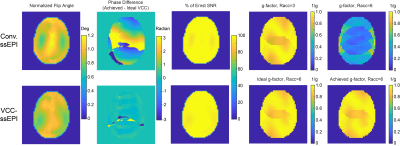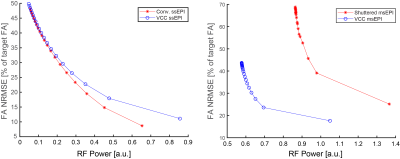0887
High Resolution EPI with Multi-spoke Parallel Transmission and Virtual Coil Reconstruction
Zhipeng Cao1
1Vanderbilt University, Nashville, TN, United States
1Vanderbilt University, Nashville, TN, United States
Synopsis
Novel encoding method based on multi-spoke parallel transmission is presented for distortion-minimized high resolution single and multi- shot GRE-EPI. By jointly designing flip angle patterns and excitation phase dictated by a 32-channel receive array using an 8-channel transmit array, the acceleration ratio of parallel imaging is drastically increased, with x6 for ssEPI and x8 for msEPI, potentially enabling sub-mm resolution and motion insensitive fMRI and diffusion MRI at UHF.
Introduction
Ultra-high field (UHF) MRI promises not only unprecedented image SNR but also stronger Blood-oxygen-level-dependent (BOLD) contrast, and therefore it is an essential tool to map human brain connectivity and function. However, high resolution functional and diffusion MRI at UHF suffer from image geometric distortions with long EPI echo train length (ETL). A common strategy to reduce EPI geometric distortion is by using parallel imaging (PI). Here, novel strategies to reduce ETL for single and multi-shot EPI (ssEPI & msEPI) is proposed based on parallel transmission (pTx) as a novel encoding approach to enable high acceleration PI reconstruction with the virtual conjugate coil (VCC) concept [1].Theory & Method
While previous literature on VCC-PI [1] has provided a proof-of-principle demonstration with tailored non-selective spiral excitation pulses 3T, here it is extended to 7T, with 8-channel pTx, slice-selective multi-spoke pTx pulse, and gradient echo based ssEPI, and further extended to enable a novel msEPI strategy that not only enables highly reduced ETL but also overcomes the major challenge of motion-induced phase errors between the shots.Different from conventional ssEPI during which pTx is mainly used to achieve homogeneous excitation, here in the proposed VCC-ssEPI, the pulse design targets both a homogeneous excitation pattern and the optimal VCC phase so that the ETL can be further reduced by half. Different from previously-presented shuttered msEPI [2,3] which is less sensitive to phase errors between the shots than conventional msEPI but more sensitive to transnational motion, a new VCC-msEPI is proposed to overcome these limitations by targeting VCC phase and continuous band patterns with 1/(#shot) of the phase encoding FOV for each shot.
The proposed VCC-ssEPI and VCC-msEPI were validated by simulation with an 8Tx32Rx head coil and a human head phantom (virtual family) [4] at 7T with XFDTD (Remcom Inc). The 8Tx was arranged as 1-row-and-8-loop-per-row. The 32Rx was arranged as 4-row-and-8-loop-per-row. The optimal VCC phase was first calculated based on the 32Rx B1- profiles, and then with it 3-spoke bipolar pTx pulses (8.7ms duration) were designed based on small-tip-angle approximation [5], with 8Tx B1+ profiles, 1mm slice thickness, and minimized total RF power. By targeting gray matter tissue with T1=2s, assuming TR=2s and thus Ernst angle of 68o, the flip angle related SNR was also analyzed.
Results
Fig 1 compares different 2D multislice ssEPI with pTx from an example slice. The conventional ssEPI typically optimizes the flip angle homogeneity with pTx. The proposed VCC-ssEPI jointly optimizes the flip angle homogeneity and the excitation phase dictated by the 32Rx receive array. It shows the optimal VCC phase is easily achievable with the 8Tx array with 3-spoke pulses, and with it the SENSE g-factor with Racc = 6 can be kept at similar levels as conventional PI with Racc = 3, and with about 6~8 times higher 1/g than conventional PI with Racc = 6. It also shows even with joint target phase design, the inhomogeneity of flip angle did not result in obvious SNR degradation based on the Ernst angle analysis for VSS-ssEPI.Fig 2 compares different 2D multislice msEPI with pTx from an example slice.The shuttered msEPI targets several separated bands during each shot. With limitations from pulse duration, RF power, and degree of freedom from 8Tx, it was very difficult to achieve the ideal shuttered excitation patterns, and this degraded the SENSE 1/g map. The proposed VCC-msEPI was more capable to achieve the continuous and wider excitation patterns, and this maintained high level of 1/g map. Not only the VCC-msEPI has a 1.5-1.7 times 1/g and SNR than the shuttered msEPI, the former can be less sensitive to transnational motion than the latter with fewer edges from shot patterns.
Fig 3 compared the flip angle NRMSE and RF power trade-off relationships ('L-curve') between different ssEPI and msEPI methods. Results showed the VCC-ssEPI has minimal disadvantage over conventional ssEPI based on the L-curve relationship, while the VCC-msEPI has much more favorable L-curve than the shuttered msEPI.
Discussion & Conclusion
New VCC-ssEPI and VCC-msEPI are proposed with pTx encoding and VCC-PI reconstruction that enable high PI acceleration factor and reduced ETL to minimize geometric distortions for high resolution EPI. In addition, compared to shuttered msEPI, the wider excitation patterns by VCC-msEPI was easier to achieve by pTx spokes pulses with higher 1/g factor and reduced RF power. With distinctive and wide excitation patterns between the shots, the VCC-msEPI can be less sensitive to all motion effects.Acknowledgements
No acknowledgement found.References
[1] Kettinger et al, MRM 2018; 79: 2113-2125.
[2] Taviani et al, MRM 2017; 77: 209-220.
[3] Cao et al, Proc. ISMRM 2018 #0386.
[4] Christ et al, Phys Med Bio 2009 (doi.org/10.1088/0031-9155/55/2/N01)
[5] Grissom et al, MRM 2012; 68: 1517-1526
Figures

Figure 1. Demonstration of VCC-ssEPI compared to conventional ssEPI. With an 8Tx array and an 8.7ms 3-spoke pTx pulse, the VCC-ssEPI jointly achieved a relatively homogeneous flip angle distribution and the target VCC phase optimized by the 32Rx array, showed no obvious SNR degradation due to flip angle homogeneity, and achieved same SENSE g-factor with x6 acceleration as the conventional ssEPI with x3 acceleration.

Figure 2. Demonstration of VCC-msEPI compared to shuttered msEPI, showing the ideal excitation patterns, achievable excitation patterns from pTx pulse design, and the 1/g factor map from different excitation strategies. Off-target excitation between the bands cannot be minimized with limited pulse duration and RF power limit, and the shuttered msEPI showed degraded 1/g map and thus reduced SNR compared to VCC msEPI.

Figure 3. Trade-off relationships between excitation flip angle error and RF power ('L-curve') comparing conventional ssEPI and proposed VCC-ssEPI, shuttered msEPI and proposed VCC-msEPI. Data obtained from whole brain pTx pulse design.